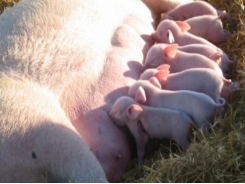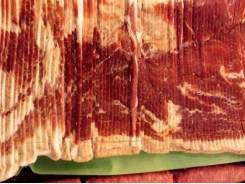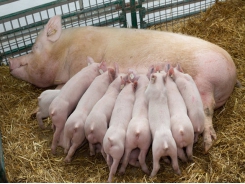Microalgae coproducts may boost health, support growth in nursery pigs

Microalgae may be an environmentally sustainable feed ingredient for pigs while providing a health boost when added to diets in small amounts, says researcher.
The use of coproduct microalgae as a feed additive or feed ingredient was an area of interest as the byproduct is generated by the biofuel industry, said Pedro Urriola, corresponding author and assistant professor at the University of Minnesota.
“In our research, we used it at [several] inclusion rates,” he told FeedNavigator. “We put it up to 30% of the diet, or [thought that] maybe at low inclusion rates there would be something that would be beneficial either to the intestinal health of the animals or that helps the piglet grow better.”
His team from the University of Minnesota examined the use of a partially de-oiled microalgae ingredient in the diets of young pigs both as a potential feed ingredient or a feed additive in relation to pig growth and health. The group members published their work in the journal of Translational Animal Science.
“We partially saw some of that benefit when we added it at 1%,” Urriola said. “Piglets’ consuming the microalgae required less treatment and their growth was better than the piglets in the control, and when we did more analysis as to metabolites there were changes in nitrogen metabolism that may point toward some benefits.”
Exploring microalgae use
Examining the potential for microalgae use in swine diets was of interested because the coproduct is generated by several industries, said Urriola.
“There are other companies using microalgae for biofuels and they’re still interested – people working on developing new strains of microalgae,” he said. “The objective has always been – let’s grow the microalgae for biofuels and then the secondary benefits would be to feed animals.”
It is not likely that microalgae will be produced solely for use in animal diets when it can be generated as a coproduct for other industries, he said.
The single-cell microorganisms also have been of interest for animal producers as microalgae grow quickly and can generate a nutrient-rich biomass, the researchers said. Potentially, the biomass would have a lower carbon, water or land footprint than other feed ingredients.
Depending on the strain of microalgae used, it can include a range of protein, lipids, carbohydrates along with bioavailable vitamins and trace minerals, they said. Strains also can include antibacterial, antiviral and antioxidant agents, meaning they could have a role as nutraceuticals or as prebiotic carbohydrates in animal feed.
However, there is little information available regarding the benefits or use of microalgae coproducts in swine diets, they said. Earlier studies found that some strains could be added to diets without negatively influence growth performance or that it could be used to replace soy protein without causing diarrhea or gastrointestinal lesions.
Microalgae biomass may provide nutritional or beneficial properties that are not currently known, they said.
Feeding trials
In the piglet study, 300 pigs were given one of five diets for a period of 42 days, the researchers said. The diets included a soybean meal-corn-based control and diets with 1, 5, 10 or 20% microalgae extract (MAE) used to replace some of the corn.
Diets also were tailored to piglet life stage and they were formatted to meet or exceed recommended nutrient requirements, they said.
The MAE coproduct used was commercially generated, and analyzed for moisture, crude protein, ether extract, ash, amino acid profile and fatty acid profile, they said. The carbohydrate composition also was examined.
Piglet body weight and feed intake were recorded weekly along with growth performance, mortality and health treatment data, the researchers said. Average daily gain, average daily feed intake and the gain to feed ratio were calculated.
At the end of the trial, a selection of pigs was harvested and portions of the jejunum and ileum were gathered for analysis along with liver samples.
Results
In the feeding trial, the piglets getting the diets supplemented with 1% or 5% MAE had the highest average daily gain and improved average daily feed intake, the researchers said. Final body weights also were higher for piglets on those diets.
The pigs on the 1 and 5% diets tended to have a lower concentration of ammonia in the liver and saw changes in metabolites involved with the urea cycle, they said.
Piglets on the control diet had worse mortality rates and needed more health interventions than those getting the supplemented diets, they said. The calculated livability index was 81.7, 93.3, 90, 96.7 and 93.3% for the control, 1, 5, 10 and 20% diets.
The groups of pigs getting the diets with 10 and 20% MAE had the highest survival rates, as no piglets died, followed by piglets on the 1% diet, they said. However, piglets getting the supplemented diets at 1 and 5% saw slightly fewer piglets need additional medical support.
However, the supplemented diets did not alter the height of intestinal mucosa or amount of mucus-producing cells in the jejunum, the researchers said. But, the ileum of pigs getting the 5% supplemented diet tended to have less mucosal height compared with pigs on the 20% diet.
The coproduct used in the trials was likely predominately carbohydrates because the lipids and proteins had already been removed, said Urriola. “What they had left had a high carbohydrate concentrate,” he added.
There may have been elements in the coproduct that were not digestible in the small intestine, he said. However, components were fermentable and acted as a prebiotic for the piglets.
The components of the feed additive could have supported the growth of beneficial bacteria in the GI tract, he said. “We did not measure that and we didn’t measure the changes in microbial population – but we did some measurements of metabolites and changes to ammonia [and we] may presume there is a group of microbes that had a beneficial effect that can be seen in the changes in ammonia.”
“There is interest in finding alternatives to antibiotics and the market space is growing and open,” he said. “So maybe it’s a matter of making it into volumes that you can market as an alternative to antibiotics.”
Looking forward
Although more trials would be needed to fully assess the use of the microalgae coproduct as a prebiotic feed additive, the research team has been moving forward with a different line of inquiry, said Urriola.
“We have a different project where we’re using microalgae to clean manure wastewater,” he added. “We’ve been taking waste water and growing different kinds of microalgae and then are using that microalgae [or its] byproducts in the future to feed calves.”
Use of wastewater from dairy or slaughter facilities to generate microalgae is another area to be explored, as the water needs to be cleaned and it could provide a new feed or feed ingredient source, he said. However, the process also has to check the microalgae produced in that manner for unintended elements that could be concentrated during the water cleaning process.
Source: Translational Animal Science
Authors: P Urriola, J Mielke, Q Mao, Y-Tai Hung, J Kurtz, L Johnston, G Shurson, C Chen, M Saqui-Salces
Related news
Tools

Phối trộn thức ăn chăn nuôi

Pha dung dịch thủy canh

Định mức cho tôm ăn

Phối trộn phân bón NPK

Xác định tỷ lệ tôm sống

Chuyển đổi đơn vị phân bón

Xác định công suất sục khí

Chuyển đổi đơn vị tôm

Tính diện tích nhà kính

Tính thể tích ao




 Reduced mineral digestibility may affect sow longevity
Reduced mineral digestibility may affect sow longevity  Supplement sow, not piglet diets with feed additives
Supplement sow, not piglet diets with feed additives